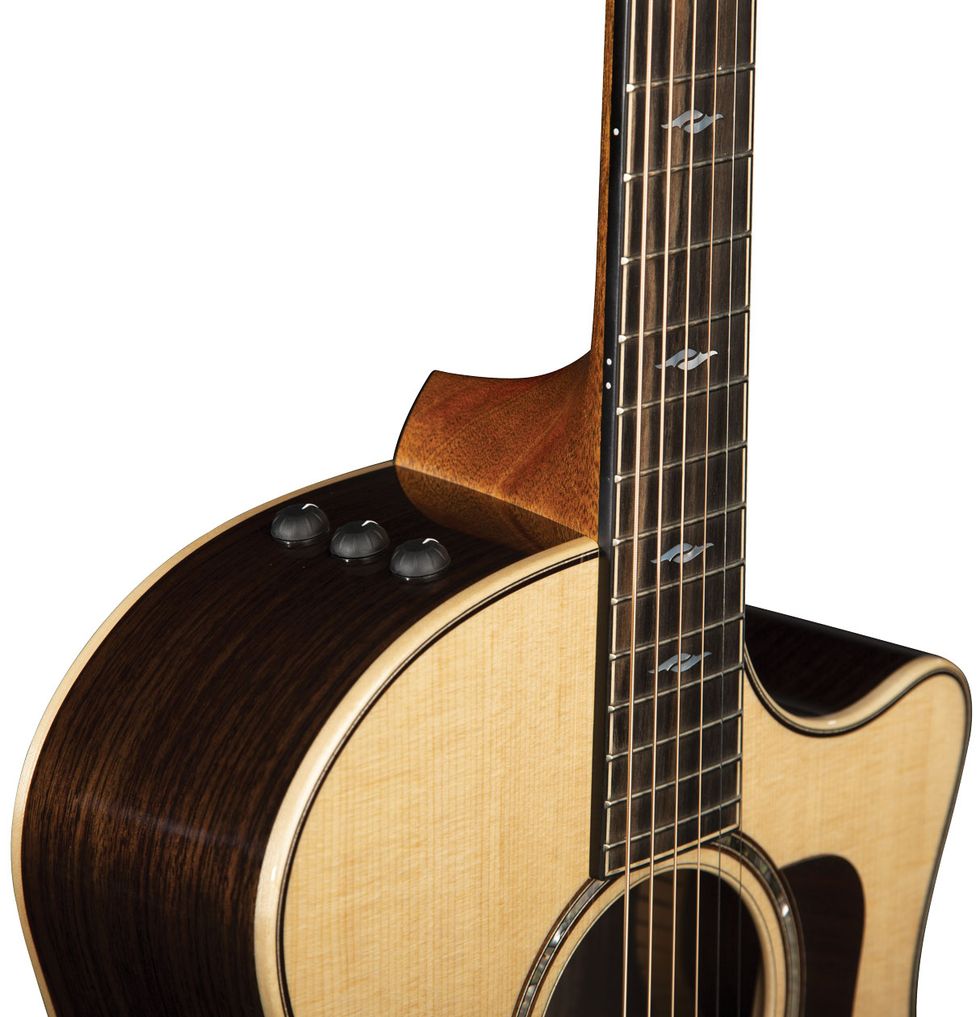When we consider the sound of an acoustic guitar, our thoughts naturally focus on the body. After all, it’s obvious this resonant, amplifying chamber is responsible for converting string movement into audible sound. Less obvious is the influence the neck has in this sonic stew. Most electric guitar players are familiar with this idea, citing the different sounds of a maple fretboard compared to rosewood or ebony. In the world of acoustic guitar, these influences—along with neck size and shape—usually get blended among the myriad of variables that make up the sound we enjoy.
To better understand the sonic role the neck plays, imagine the neck as one leg of a tuning fork, with strings attached. Every time a string moves, the neck will vibrate in response. This vibration changes based on how comparatively stiff or flexible the neck of the guitar is. To demonstrate this, we could hold a thin, wooden coffee-stirring stick against a countertop with a portion extending into the air. If we flick the free-floating end, we’ll see and hear the stick vibrate. Extending the free-floating portion will allow more flexibility and result in lower pitch, while shortening it reduces the flexibility and raises the pitch we hear. Switching to a thinner or thicker stick will also result in more- or less-flexible results, with corresponding lower or higher pitches.
When applied to the actual guitar neck, it’s easy to start listing the variables at play. We certainly need to consider the overall length, which is driven by both scale length and where the neck and body are joined. Then there are the wood types for the neck and fretboard, the size and shape of the neck, internal elements such as a truss rod or reinforcement bars, and even the tightness of pressed-in frets, each of which acts like a miniature wedge imparting stiffness in the neck. All these variables factor into the strength and sound of that neck.
While all these factors matter, the one that really captures my attention is the size and shape of the neck. Most often, guitar players evaluate the shape of a neck in terms of comfort alone, and for good reason. If a guitar isn’t comfortable to play, we won’t play it. And then it won’t matter what it sounds like, right?
As a guitar maker, however, a second consideration after comfort is what this neck shape is going to sound like due to its stiffness. Interestingly, the depth (or distance) from the face of the fretboard to the apex of the back curve is a more significant factor than one might think.
To highlight this in most engineering equations used to calculate beam strength, a cross section of the beam is one of the parameters factored in. When an engineer enters this cross section into a formula, it will usually be measured as height, multiplied by itself, multiplied by itself again, and then multiplied by its width. If that is any indication, the height parameter—or a change of neck thickness—matters a whole lot. To experience what this looks and sounds like, we could return to our coffee-stirring stick on the counter. Held flat against the counter with the end hanging over, we can pluck it and hear the sound. Holding the same stick on edge with the same length overhanging the counter, plucking the free end will result in a far higher pitch, even though the stick is the same and the amount of wood has not changed.
By the time we consider all the factors that affect neck stiffness and ask what a stiff neck sounds like compared to a more flexible one, the answer is somewhat ambiguous, as it is wrapped up in the variables with the rest of the guitar. To make some generalizations: As a neck is vibrating, it acts like a shock absorber for a string’s vibration. A flexible neck will want to absorb more of a string’s motion, and at a lower frequency where notes we play might reside. This can cause a mysterious “dead note” on a fretboard, where a note seems to not exist or resonate after we play it. A neck with more stiffness will tend to vibrate in a register far above the audible notes a guitarist plays, where its vibration is less likely to cancel out the audible notes we want.
To this end, makers have thankfully sought construction methods to increase the stiffness of necks. By using metal bars, denser woods, or, more recently, carbon-fiber composites, builders can make necks stiff and lively sounding without relying on cumbersomely large shapes like some makers did in eras past.



















